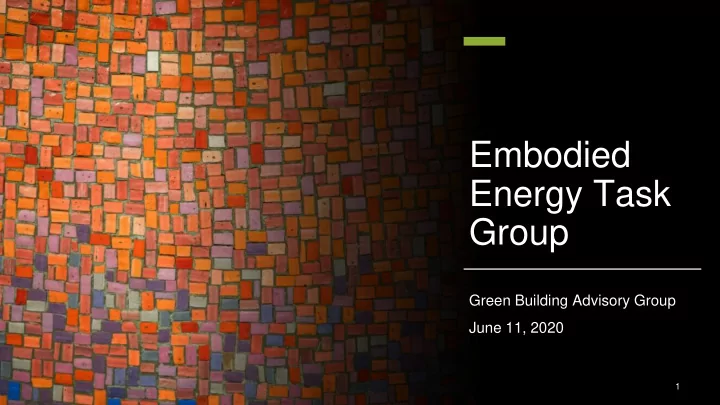

Embodied Energy Task Group Green Building Advisory Group June 11, 2020 1
Disclaimer These notes represent the deliberations of a task group to an independent advisory committee, and as such, may not be consistent with current GSA or other Federal agency policy. Mention of any product, service or program herein does not constitute endorsement. 2
Embodied Energy Task Group Mission Statement The Embodied Energy Task Group (EETG) is set up within the General Services Administration Green Building Advisory Council (GSA GBAC) to study the Federal energy, pollution, and cost savings that may be achieved by reducing the energy and carbon embodied in building construction. Assuming the potential savings are significant, the EETG will produce relevant and readily adoptable procurement recommendations for the GSA to encourage the adoption of low embodied energy and carbon materials. 3
Task Group Participants Audrey Rempher Matt Junglcaus Jenna Hamilton Victor Olgyay (Co-Chair) Dorothy Robyn Alison Kinn Mark Thimons Brendan Owens Rebecca Stevens Bruce King Josh Kneifel (Co-Chair) Stacy Smedley Don Horn Jed Ela Jennifer Frey Kevin Carbonnier Michael Bloom Kent Peterson Walter Tersch Jane Rohde Heather Goetsch Saif Sadeq Kate Simonen Lance Davis Steve Bruno Frances Yang Alex Rogers Clay Nesler Dirk Kestner Theresa Blaine Elizabeth Beardsley Erin McDade 4
Questions for the GBAC • How can we make these guidelines most relevant and effective? • Suggestions for additional resources we might reference? • Other existing policy vehicles we should be examining? • Thoughts on the application of the guidelines? 5
6
7
Task Group Approach 1. Value of Embodied Energy /Carbon • What is the value of this opportunity? 2. How to access value for GSA • Recommended approach to guidelines 3. Low EE/EC Procurement guidelines • Draft procurement guidelines 4. GSA Advice letter Lloyd D. George Courthouse 8
Work Done to Date (Presentations) • Time Value of Carbon (Erin McDade, Architecture 2030) • GSA Project Completions 2009-2019 (Walter Tersch, GSA) • Understanding Carbon (Stacy Smedley, Skanska & Building Transparency) • Business Case for Reducing Carbon (Monika Henn, Urban Land Institute) • Low Carbon Concrete (Bruce King, Ecological Building Network) • Sustainable Purchasing Implementation (Rebecca Stevens, GSA) • EPA Tools for Assessing Environmental Impact (Alison Kinn, EPA) • Building Materials, Embodied Carbon and California’s Buy Clean Policy ( Kate Simonen, University of Washington & Carbon Leadership Forum) • Reducing Embodied Environmental Impacts of Buildings: Policy Options and Technical Infrastructure (Jennifer O’Connor, Athena Institute) • Embodied Carbon in LEED v4.1 (Brendan Owens, USGBC) 9
Deliverable #1: Preliminary Assessment What is the value to the GSA (and ultimately, to the taxpayer) of considering the energy used during the manufacture, transportation, and installation of materials used in the construction and renovation of the GSA’s buildings? This was assessed in three steps: 1. Assess the total annual construction rates of the GSA as a whole 2. Estimate reasonable reductions that could be assumed from this baseline, and 3. Calculate the value of those savings from a variety of perspectives, including energy cost, carbon, public health, and climate mitigation 10
1: Assessing GSA’s annual construction rates We looked at 487 GSA projects completed between 2009 and 2019, affecting over 253 million gross square feet, with a total value of $11.3 billion. 67% of these projects affected office buildings, including combination office/courthouses. On average, per year, there were 44 projects completed, affecting 23M GSF, with a value of $1.03B. 11
2: Estimate anticipated reduction from baseline • 633 million kg-CO 2 e potential annual savings • Roughly 633,000 metric tons CO 2 e/year - the equivalent of 72,000 homes annual energy usage • Accepted practice assumes that a 30% reduction from baseline can be typically achieved with zero to marginal cost increase 12
3. Benefits from reducing embodied carbon ● Reduction of supply chain energy costs ○ Estimated as $13 million per year ● Reduced cost from more material-efficient designs ● Ease of regulatory compliance ● Reduction in air pollution ○ Estimated as to $12 million per year ● Mitigating climate change-related costs 13
Deliverable # 2: Recommended approach to guidelines Initial TG agreements: ● Criteria for GSA adoption of low EC procurement guidelines ● Approaches to process ● Material Categories – primary content of guidelines 14
Recommended approach to guidelines Material Categories – primary content Approaches to process Criteria for adoption of guidelines of guidelines ● Easy to rapidly adopt Tentative adoption of a “Dual General List to include the following: ● Effective in securing significant value Approach”, based on size of project, ● Concrete for the GSA and public (low cost, ● Aluminum better performance) ● Very small projects may be ● Steel ● “Automaticity” — Incorporating exempt continued improvement, without ● Wood ● Medium projects “interior fit ● Thermal and moisture control revising policy, e.g. by reference to outs” for example, would ● Glass baselines (like Energy Star) or require EPD for most materials ● Gypsum Board external policy (e.g. USGBC/LEED) ● Large projects “New ● Ceiling Panels (maybe) construction and major ● Flooring ● Non- controversial, non-partisan renovation” would require a ● Stone and masonry ● Easy, simple, understandable whole building LCA. ● Compatible with existing Federal Guiding idea: “Don’t define the product list too tightly; let /GSA / Industry systems the project requirements / design team dictate ● Ease of implementation as criteria the materials to be evaluated” 15
Next steps: • Complete Recommended approach to guidelines • (June 16th) • Produce draft guidelines • (June 17th - July 15th) • Draft Assessment Letter / Completion of Task Group • (August 25th) 16
Questions for the GBAC • Can we make these guidelines most relevant and effective? • Suggestions for additional resources we might reference? • Other existing policy vehicles we should be examining? • Thoughts on the application of the guidelines? 17
Thank You Embodied Energy Task Group 18
Recommend
More recommend